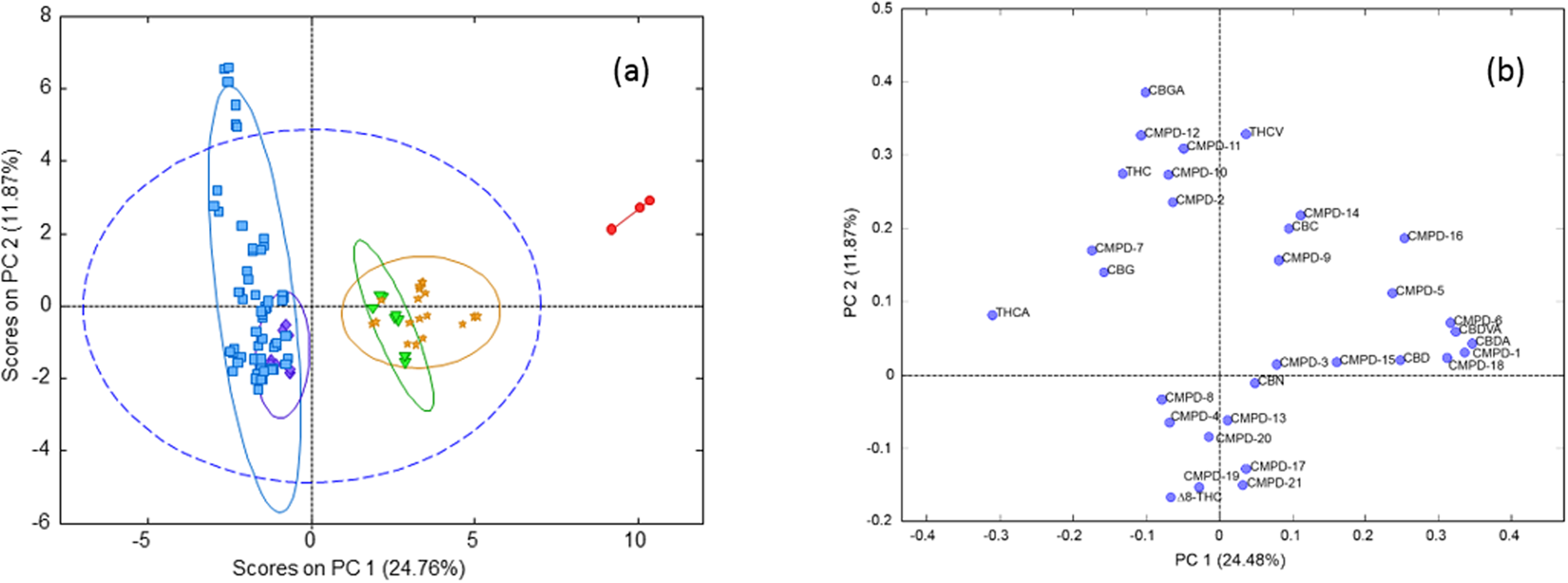Difference between revisions of "Template:Article of the week"
Shawndouglas (talk | contribs) (Updated article of the week text) |
Shawndouglas (talk | contribs) |
||
| (One intermediate revision by the same user not shown) | |||
| Line 1: | Line 1: | ||
'''"[[Journal: | <div style="float: left; margin: 0.5em 0.9em 0.4em 0em;">[[File:Fig3 Mudge ScientificReports2018 8.png|240px]]</div> | ||
'''"[[Journal:Chemometric analysis of cannabinoids: Chemotaxonomy and domestication syndrome|Chemometric analysis of cannabinoids: Chemotaxonomy and domestication syndrome]]"''' | |||
''[[wikipedia:Cannabis|Cannabis]]'' is an interesting domesticated crop with a long history of cultivation and use. [[wikipedia:Cannabis strains|Strains]] have been selected through informal breeding programs with undisclosed parentage and criteria. The term “strain” refers to minor morphological differences and grower branding rather than distinct cultivated varieties. We hypothesized that strains sold by different licensed producers are chemotaxonomically indistinguishable and that the commercial practice of identifying strains by the ratio of total Δ9-[[wikipedia:Tetrahydrocannabinol|tetrahydrocannabinol]] (THC) and [[wikipedia:Cannabidiol|cannabidiol]] (CBD) is insufficient to account for the reported human health outcomes. We used targeted [[wikipedia:Metabolomics|metabolomics]] to analyze 11 known [[wikipedia:Cannabinoid|cannabinoid]]s and an untargeted metabolomics approach to identify 21 unknown cannabinoids. Five clusters of chemotaxonomically indistinguishable strains were identified from the 33 commercial products. Only three of the clusters produce cannabidiolic acid (CBDA) in significant quantities, while the other two clusters redirect metabolic resources toward the [[wikipedia:Tetrahydrocannabinolic acid|tetrahydrocannabinolic acid]] (THCA) production pathways. ('''[[Journal:Chemometric analysis of cannabinoids: Chemotaxonomy and domestication syndrome|Full article...]]''')<br /> | |||
<br /> | <br /> | ||
''Recently featured'': | ''Recently featured'': | ||
: ▪ [[Journal:National and transnational security implications of asymmetric access to and use of biological data|National and transnational security implications of asymmetric access to and use of biological data]] | |||
: ▪ [[Journal:Developing workforce capacity in public health informatics: Core competencies and curriculum design|Developing workforce capacity in public health informatics: Core competencies and curriculum design]] | : ▪ [[Journal:Developing workforce capacity in public health informatics: Core competencies and curriculum design|Developing workforce capacity in public health informatics: Core competencies and curriculum design]] | ||
: ▪ [[Journal:Assessing cyberbiosecurity vulnerabilities and infrastructure resilience|Assessing cyberbiosecurity vulnerabilities and infrastructure resilience]] | : ▪ [[Journal:Assessing cyberbiosecurity vulnerabilities and infrastructure resilience|Assessing cyberbiosecurity vulnerabilities and infrastructure resilience]] | ||
Revision as of 18:14, 1 July 2019
"Chemometric analysis of cannabinoids: Chemotaxonomy and domestication syndrome"
Cannabis is an interesting domesticated crop with a long history of cultivation and use. Strains have been selected through informal breeding programs with undisclosed parentage and criteria. The term “strain” refers to minor morphological differences and grower branding rather than distinct cultivated varieties. We hypothesized that strains sold by different licensed producers are chemotaxonomically indistinguishable and that the commercial practice of identifying strains by the ratio of total Δ9-tetrahydrocannabinol (THC) and cannabidiol (CBD) is insufficient to account for the reported human health outcomes. We used targeted metabolomics to analyze 11 known cannabinoids and an untargeted metabolomics approach to identify 21 unknown cannabinoids. Five clusters of chemotaxonomically indistinguishable strains were identified from the 33 commercial products. Only three of the clusters produce cannabidiolic acid (CBDA) in significant quantities, while the other two clusters redirect metabolic resources toward the tetrahydrocannabinolic acid (THCA) production pathways. (Full article...)
Recently featured:










